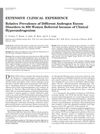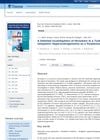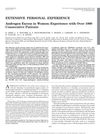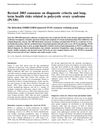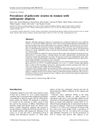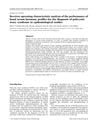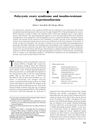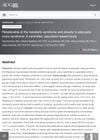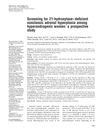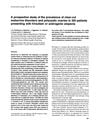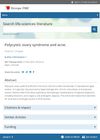The Androgen Excess and PCOS Society Criteria for the Polycystic Ovary Syndrome: The Complete Task Force Report
October 2008
in “
Fertility and Sterility
”
polycystic ovary syndrome PCOS hyperandrogenism alopecia hirsutism insulin resistance metabolic syndrome thyroid dysfunction hyperprolactinemia 21-hydroxylase-deficient nonclassic adrenal hyperplasia NC-CAH Cushing's syndrome androgen-secreting neoplasms hair loss excessive hair growth thyroid issues high prolactin levels adrenal hyperplasia Cushing's disease androgen tumors

TLDR The report concludes that PCOS is mainly a condition of excess male hormones and its definition may change as new information is discovered.
The 2009 report by the Androgen Excess and PCOS Society Task Force established criteria for diagnosing polycystic ovary syndrome (PCOS), defining it by the presence of hyperandrogenism (clinical and/or biochemical), ovarian dysfunction (oligo-anovulation and/or polycystic ovaries), and the exclusion of related disorders. The Task Force reviewed literature from 1980 to 2005, focusing on studies with over 100 subjects, and found strong evidence of PCOS's familial pattern and its multifactorial polygenic nature. They reported that 67% of women with alopecia had polycystic ovaries, 36.5% of 109 premenopausal women with alopecia had PCOS, and 27.1% of women with menstrual dysfunction had PCOS. The prevalence of PCOS was higher in women with hirsutism compared to those with alopecia only. The report also discussed the prevalence of metabolic and reproductive abnormalities in PCOS, noting that 50% to 70% of women with PCOS have insulin resistance, and 33% to over 50% have metabolic syndrome in the US. Thyroid dysfunction and hyperprolactinemia were found to be relatively rare in PCOS patients. The Task Force recommended routine screening for 21-hydroxylase-deficient nonclassic adrenal hyperplasia (NC-CAH) in hyperandrogenic women, especially in high-risk populations, but not for Cushing's syndrome or androgen-secreting neoplasms unless symptoms are present. The report concluded that PCOS is primarily a hyperandrogenic disorder and that the definition of PCOS would likely evolve with new research findings.

